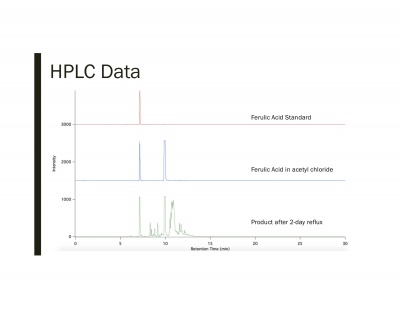Synthesis and Characterization of Lignin Monomers
Abstract: Lignin is the second most abundant organic polymer. The structure of lignin is composed of three monomers: p-coumaryl alcohol, coniferyl alcohol, and sinapyl alcohol, which all are found in nature. These natural compounds are not cost friendly for undergraduate research. The carboxylic acid forms of these monomers (p-coumaric acid, ferulic acid, and sinapic acid) can be obtained commercially. This poster will discuss our synthetic approaches to produce the alcohol forms of lignin.
Introduction: Ferulates play important roles in plant growth and undergo radical coupling reactions to produce dimers and cross-linking. Significant quantities are now required by cell wall researchers increasing the the large scale production of these ferulates and other lignins similar to their make up.
Synthesis Mechanism:
Synthesis:
- Ethyl Ferulate: 10 g of ferulic acid dissolved in 100 mL ethanol and 5 mL of acetyl chloride. Solution stirred overnight. Volatiles removed by rotary evaporation (rotovap) at 40 C. (Ralph)
- Esterification: 0.36 M ferulic acid in ethanol (500 mL) with concentrated HCl. Refluxed for two days. Cooled and ethanol evaporated under pressure (rotovap). Crude extract combined with ethyl acetate (250 mL). Solution dried over anhydrous MgSO4.
Data:

